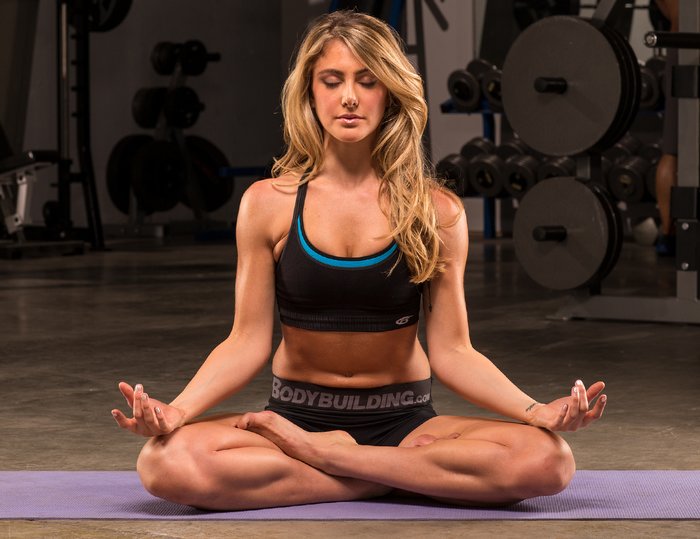The act of breathing is simplicity itself: Air flows into and is then expelled from the lungs. It's an automatic function of the body that keeps us alive and active. While the action of breathing is automatic most of the time, we do have control over how we do it and when we choose to exert that control. And, how we use that breath during physical activities can influence our performance in the gym.
That's mostly due to the diaphragm, the muscle that controls the act of breathing. The diaphragm is a dome-shaped muscle, located across the bottom of the thoracic cavity, which flattens as it contracts. This increases the volume inside the cavity, and pulls air in. When the diaphragm relaxes, the volume within the cavity decreases, and pushes the air out.
But your breathing changes in response to your circumstances as well, and often with very good reason. Ask yourself three questions:
- What did you do when you were huffing and puffing during your last rapid-fire workout? You likely sucked in bigger breaths to bring down your heart rate.
- How do you typically breathe when you struggle to eke out a final rep of your heaviest set? You probably hold your breath to help create more core tension during the lift.
- If you were in a fight and saw a punch to your gut coming, what would you do? You would brace for that punch by holding your breath and contracting your abdominals.
The upshot is that your body innately understands the function of breathing during physical activities and stress, and it adjusts accordingly. Learning to harness the natural power of breath means that we can improve lifts, stabilize the spine, and increase our recovery through the simple act of breathing.
Below are four drills to help you practice increasing your breath control as you learn to focus your mind, brace your spine, and wash away daily stress.
1. Anytime: Yogic Breathing
The type of breathing known in Sanskrit as "ujjayi" (ocean breath), is an active breathing pattern that is best practiced in a comfortable, seated position. It's very common in yoga classes, but it's also worth practicing at home, off the clock, and outside of the gym.

Before we learn to control our breath we have to feel it, and that's what ujjayi breathing teaches. It gives insight into how breathing works, and how you can develop the ability to slow it down or speed it up. When you learn to control it in this way, you'll be better able to use it as a tool in your training.
How to:
- Sit up tall, with your chest wide and your shoulder relaxed.
- Close your eyes and begin to breath in and out through your nose. Slow the breath down and create a 4-count inhale and a 4-count exhale.
- After you've established this rhythm, begin to constrict the back of your throat as you breathe. This will produce the slightly rumbling ocean sound that accompanies this breathing exercise.
- Continue this for a total of 5 minutes, trying to maintain your focus, and maintain the breath.
2. Pre-workout: Alternate-Nostril Breathing
This breathing exercise teaches you to bring your focus to each breath. It is a perfect pre-workout practice to help center your body and mind before you train.
How to:
- Start in a comfortable seat, with your shoulders relaxed and your chest open.
- Close your eyes, and begin to breath slowly in and out through your nose. Spend ten inhalation-exhalation cycles of breath before you move on to the next step.
- Take your right thumb and use it to close your right nostril. Inhale slowly through your left nostril.
- Close your left nostril with your right ring finger, and exhale through your right nostril.
- With your right thumb, close your right nostril and inhale through the left. Then, close the left, and exhale through the right. Continue this way for up to 10 cycles of breath.
3. Intra-workout: Brace-and-Hold Breathing
This exercise directly contributes to the strength and success of your lifts. Understanding how to pull your core muscles in toward your center to brace your spine, while still maintaining a rhythmic breath, means stronger, safer training.

How to:
- Start standing, with your shoulders relaxed and your feet hip-width apart.
- Draw a huge inhale through your nose, and hold your breath as you pull your ribs in and down, as if bracing for a punch in the stomach.
- Hold this for a slow count of five, then exhale through your mouth, only releasing about 50 percent of the tension you created throughout your core.
- Inhale deeply through your nose, hold complete tension for a slow count of five, then exhale through your mouth.
- Cycle through four rounds of breathing in this fashion, then rest for 30 seconds.
- After you've practiced this breathing pattern for three rounds, use it during your lifts. How? First, get set up to lift, take a big inhale through your nose, pull your belly and ribs in, execute the lift, then release the breath.
4. Post-workout: Recovery Breathing
This final exercise seems simple in execution, but can be challenging to maintain. The ideal time to practice this is while you stretch, post-workout or at home. This exercise can be difficult because your mind will wander and your breath will change, while the goal is to stay relaxed, present, and consistent.
How to:
- Breathe through your nose, slowly and mindfully, for at least 5 minutes. You don't have to be in a seated meditation-style posture while you do this, but if that's the only way you can concentrate, then do it. Otherwise, do it while you cool down, stretch, or even drive home from the gym.

